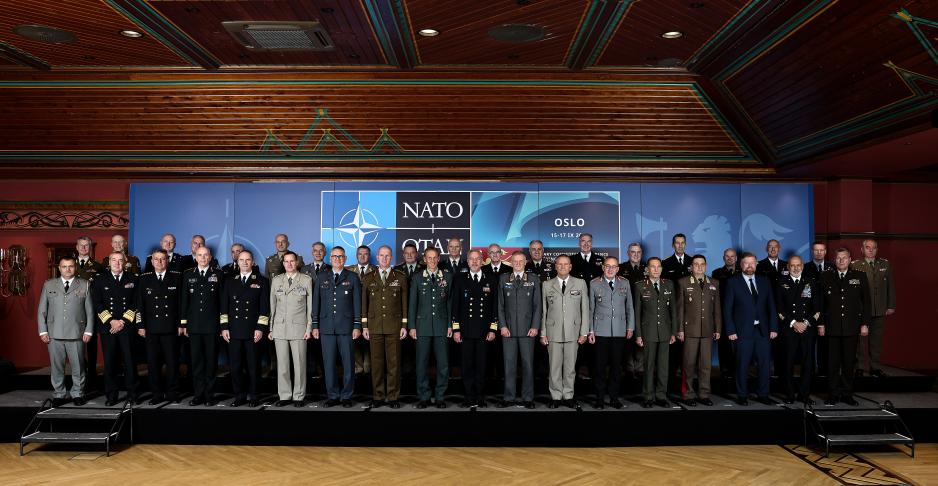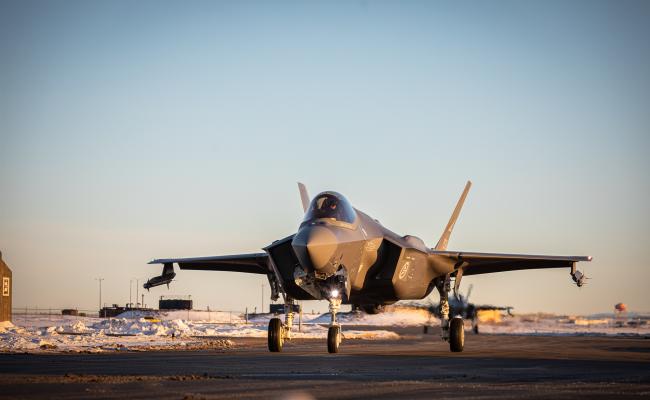Op-ed: The Transarctic Alliance is Key to US National Security

NATO's 31 chiefs of defense and more, lined up at the annual conference of the NATO Military Committee, this time hosted by Norway in 2023. Together, these chiefs lead around three million men and women in uniform. (Photo: Torbjørn Kjosvold/Norwegian Armed Forces)
This is an opinion piece written by an external contributor. All views expressed are the author's own.
I had the honor and privilege of serving as the first United States Ambassador-at-Large for Arctic Affairs. In this role I represented my country in a region of growing great power competition, where the contours of the security, political, economic, environmental, and social landscapes are rapidly shifting.
The undeniable thread woven throughout these issues are the impacts of a warming Arctic; climate change is real, rapid, and relentless.
Seven Arctic states are NATO allies (Canada, Finland, Denmark— by virtue of Greenland— Iceland, Norway, Sweden, and the US— by virtue of Alaska), and Arctic nations make up five of the sixteen founding NATO members.
Despite the current U.S. administration’s skepticism of the Alliance, it is in America’s best interest to reinforce and strengthen this strategic alignment.
The Alliance is a bulwark against nations that seek to advance ideologies antithetical to democratic values and institutions, to use tools of national power to dismiss sovereign borders, to destabilize and invade neighboring countries, and to disrupt the international rules-based order.
Look at a map of the Arctic.
The United States should strengthen the transatlantic alliance by reaffirming an unwavering commitment to it. Collectively, the seven Arctic NATO member nations, alongside other members of the Alliance, form a potent security, economic, and research partnership that benefits us all.
Look at a map of the Arctic. Find Alaska, my home state, and run your finger from there through Canada, Greenland, Iceland, Norway, Sweden, and Finland. You’ve just identified what I call the transarctic alliance.
In the aftermath of the Second World War these nations formed an arc of cooperation based on shared democratic values, a commitment to the rule of law, the recognition of sovereign borders, and with Finland and Sweden recently joining NATO, the collective defense of all Arctic allies.
From the Bering Sea to the Beaufort Sea, from the Barents Sea to the Baltic Sea, Arctic allies are navigating a new geopolitical landscape and a host of evolving and escalating military and security threats.
Allies are increasingly concerned with persistent threats posed by an emboldened Russia and China’s expanding interests and activities throughout the region. As the 2024 U.S. Defense Department’s Arctic Strategy identified, the ways in which Russia and China are cooperating “across multiple instruments of national power” is of increasing concern.
Also read (the text continues)
While serving as U.S. Ambassador, our Arctic allies reaffirmed to me a commitment to further invest in their security that will also enhance our collective defense. They underscored the importance of U.S. security capabilities and assurances and called for sustained U.S. diplomatic leadership in the region.
The U.S. should reaffirm its commitment to our Arctic allies and provide reliable leadership and predictable support; the U.S. must remain the unequivocal ally – in the Arctic and around the world.
Our Arctic allies actively defend U.S. interests in the region and around the globe. Iceland, Greenland and the Faroe Islands as part of the Kingdom of Denmark, Norway, and fellow NATO members monitor and defend the strategic GIUK Gap (the Greenland-Iceland-United Kingdom Gap).
This region contains strategic military and civilian shipping lanes from the North Atlantic to the Barents Sea. In the Arctic, Russia’s Northern Fleet gains access from the Barents Sea to the North Atlantic, the Baltic Sea, the Black Sea, and the globe beyond.
With Finland and Sweden these partners monitor and confront threats from adversaries and competitors in the inherently linked Baltic Sea region that includes overt military activity as well as grey zone tactics, cyber-attacks, electronic warfare, shadow fleets evading sanctions and posing environmental risks, and the targeting of critical undersea infrastructure.
Denmark, Greenland, and Canada deserve full recognition of their national borders
To counter threats by adversaries and competitors, the United States should reevaluate and prioritize its foreign and defense policies in the Arctic, starting with respectful engagements of longtime allies Canada and the Kingdom of Denmark.
Denmark, Greenland, and Canada deserve full recognition of their national borders and the right to chart their own future.
The U.S. should develop a defense investment plan for Greenland and the Faroe Islands, in consultation with all parties that leverages, complements, and expands upon Denmark’s recently announced $2 billion dollar defense package for both locations.
With these modest but significant steps, the U.S can increase its current capabilities in Greenland and the Faroe Islands and move more quickly and cost effectively to address the very real threats it seeks to counter.
Canada recently unveiled over CAN$6 billion in new Arctic-related defense investments to expand and enhance the Arctic capabilities of the Canadian Armed Forces, and the modernization of their portion of the North American Aerospace Defense Command or NORAD.
Also read (the text continues)
These investments will further strengthen Canadian and U.S. security, as well as the collective defense of the North American Arctic.
As a beacon of democracy, the foundation for the defense and security of the free world, and an indispensable partner for over eighty years, the United States has assumed the lion’s share of the costs associated with establishing and defending the international-rules-based order.
Allies and partners know full well cost sharing must increase if we are together going to confront the new geopolitical realities of our time, particularly the challenges and opportunities brought about by an increasingly globalized Arctic region.
A shared set of values and ideals, and a commitment to our collective security demonstrates the transarctic alliance is a critical component of the transatlantic alliance, and both are central to U.S. national security. We all have more to do, so we must do more together.



